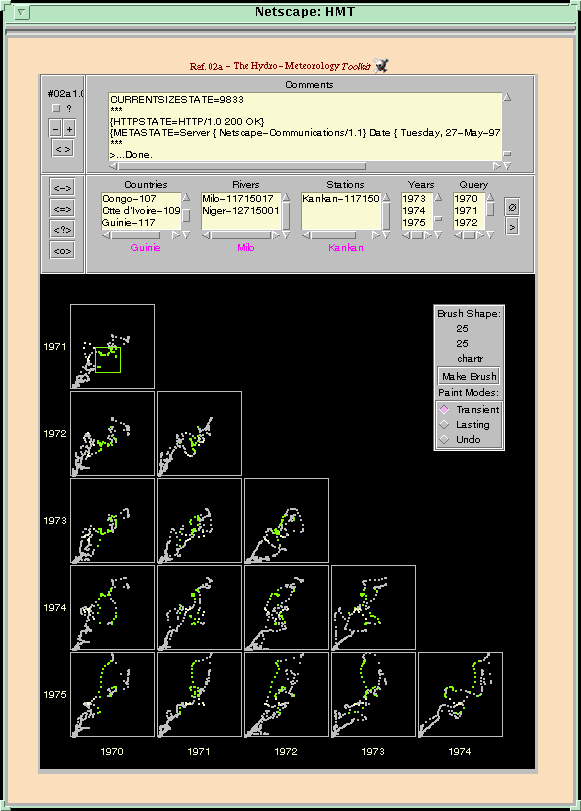|
| |||||||||||||||||||||||||||||||||||||||||||||||||||

| ||||||||||||||||||||||||||||||||||||||||||||||||||||
Fifth Annual Tcl/Tk Workshop, 1997
[Technical Program]
The Hydrology-Meteorology Toolkit Guillaume Le Stum ORSTOM, Hydrologie, BP 5045 911, Av. Agropolis F-34032 Montpellier chevenet@orstom.fr, lestum@orstom.fr Abstract The Hydrology-Meteorology Toolkit is a Tcl/Tk applets library for numerical/graphical processing hydro-meteorological data. It uses Tcl/Tk as a basic language. With the Tcl/Tk Plugin installed on the W3 browser side, applets use the HTTP protocol for querying an Oracle database server and managing i/o C programs towards Tcl CGI scripts. 1. The MED-HYCOS project The World Meteorological Organization (WMO), with the support of the World Bank, promotes the development of a World Hydrological Cycle Observing System (WHYCOS), and the first regional WHYCOS component is the MED-HYCOS project (MEDiterranean HYdrological Cycle Observing System). ORSTOM (French Institute of Scientific Research for Development through Cooperation) hosts the MED-HYCOS Pilot Regional Center. A MED-HYCOS aim is managing and numerical/graphical processing of hydro-meteorological data via the World Wide Web (W3). 2. The Hydro-Meteorology Toolkit The Hydro-Meteorology Toolkit (HMT) is a W3 tools library for the MED-HYCOS project. HMT is based on a W3-to-Database connectivity using Tcl/Tk as a basic language. An Oracle relational database management server deals with hydro-meteorological data such as streamflow discharges, temperature, rainfall, and so on. On the W3 browser side (Navigator, Explorer), HMT needs the Plugin Tcl/Tk to be installed. A Tcl applets (tclets) library deals with data edition, graphical representations, exploratory data analysis (Tukey, 1977) and multivariate statistical analysis. At present, these tclets use the Trusted security policy. Depending on user interaction, tclets use the HTTP protocol for (i), querying the database towards OraTcl CGI scripts. OraTcl is a well known Tcl extension from T. Poindexter that provides access to a Oracle Database server, and (ii), managing i/o C programs for multivariate analysis methods (e.g. Principal Components Analysis) towards Tcl CGI scripts. Figure 1 shows two tclet examples from HMT. 3. Conclusion At present, HMT is still under development, but firsts results are decisive. The Tcl/Tk environment enables a powerful Human-Machine interaction inside W3 documents, such as dynamic graphical methods (Becker, Cleveland & all, 1987), with good performances. Moreover, it facilitates the development of the information system toward the homogenization of its architecture (i.e. Tcl for the CGI scripts instead of Perl and Pro*C for the SQL queries, and Tcl/Tk for applets). References Tukey J. (1977). Exploratory Data Analysis. Addisson-Wesley. Becker R.A., Cleveland W.S. and A.R. Wilks (1987) Dynamic Graphics for Data Analysis. Statistical science, v2n4, 355-395. Figure 1 Screendumps of two tclet examples. The Tcl/Tk plugin enables dynamic graphical methods inside W3 documents with good performances. These methods have tow important properties : direct manipulation and instantaneous change. For instance moving a rectangle over a scatterplot by moving a mouse, when the rectangle covers a point, its label appears and when the rectangle no longer covers the point, its label disappears. 

|
|
This paper was originally published in the
Proceedings of the Fifth Annual Tcl/Tk Workshop 1997,
July 14-17, 1997,
Boston, Massachusetts, USA
Last changed: 16 April 2002 aw |
|